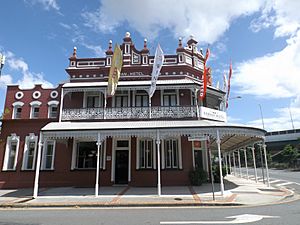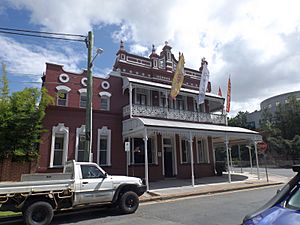Norman Hotel facts for kids
Quick facts for kids Norman Hotel |
|
|---|---|

Building in 2015
|
|
| Location | 102 Ipswich Road, Woolloongabba, City of Brisbane, Queensland, Australia |
| Design period | 1870s–1890s (late 19th century) |
| Built | 1889–1890 |
| Architect | John Beauchamp Nicholson |
| Official name: Norman Hotel | |
| Type | state heritage (built) |
| Designated | 12 July 2005 |
| Reference no. | 602539 |
| Significant period | 1880s,1890s (fabric) 1890-ongoing (historical use) |
| Significant components | cellar |
| Lua error in Module:Location_map at line 420: attempt to index field 'wikibase' (a nil value). | |
The Norman Hotel is a historic hotel located at 102 Ipswich Road in Woolloongabba, Queensland, Australia. It was designed by architect John Beauchamp Nicholson and built between 1889 and 1890. Today, it is recognized as an important heritage site and is listed on the Queensland Heritage Register.
Contents
History of the Norman Hotel
The Norman Hotel was built in 1889 for Robert Heaslop. It was designed by the office of John Beauchamp Nicholson. The hotel stands out on a busy road called Ipswich Road, at the corner of Qualtrough Street.
Early Days of Ipswich Road
In 1859, Queensland became a separate state from New South Wales. At that time, the road between Brisbane and Ipswich was considered the best road in Queensland. It is still a very important road today. Many people lived near where five tracks met, which later became known as the Woolloongabba Fiveways.
Woolloongabba's Growth in the 1880s
The area of Woolloongabba grew very quickly in the 1880s. This growth happened because new railway lines and tramways were built. Businesses and small factories also started to appear. For example, a dry dock was built in South Brisbane in 1881. Coal wharves were connected to a railway yard in Woolloongabba in 1884. The first horse-drawn trams in Brisbane started running in 1885.
In 1885, Robert Heaslop bought the land on Ipswich Road where the hotel now stands. He was part of a family that owned shops in the area.
Building the Hotel
In 1888, South Brisbane and Woolloongabba joined together to form the City of South Brisbane. A Post Office opened in Woolloongabba in 1889, served by the new tram lines. The area was booming, and Queensland's economy was doing well too. Robert Heaslop decided this was a good time to build a large hotel. He took out a loan in November 1889 to help build it. The hotel was built by F Steffans.
Other hotels were also built around this time because the population was growing. These included the Woolloongabba Hotel (1887), the Railway Hotel (1889), and Burke's Hotel (1890).
The Architect: John Beauchamp Nicholson
John Beauchamp Nicholson was born in 1852. He came to Brisbane around 1876. He started his own architecture office in October 1885. His office designed many beautiful buildings. These included the Lady Musgrave Lodge in 1891 and the Princess Theatre in Woolloongabba in 1888. He also designed several hotels and a brewery in Townsville.
Hotel Ownership and Changes
The Norman Hotel opened in June 1890. Robert Heaslop was the first person to hold the hotel's license. However, the law required the license holder to live at the hotel. So, the license was soon transferred to Henry Marsden. Robert Heaslop continued to live nearby and keep an eye on the hotel.
In 1900, a brewing company called Perkins & Co bought the hotel. This company, along with another called Castlemaine Brewery, bought many hotels. They wanted these hotels to sell only their own beer. This was a way for them to compete for customers.
The Woolloongabba area slowly declined after 1900. The hotel changed license holders over the years but stayed mostly the same. Edward Patrick (Ted) Kearney was a license holder until 1966. His wife, Elizabeth Josephine (Josey) Kearney, then ran the hotel for about 20 years. During this time, the main bar was updated, but not much else changed.
Later, the Mayes family owned the hotel. In 1987, Peter Cavill bought the license. He added a steakhouse and a large outdoor eating area in 1988. He later bought more land and made the outdoor area even bigger, seating up to 700 people. During this time, some old buildings at the back of the property, like stables and an air raid shelter, were removed.
The hotel has been renovated over the years. Some walls on the upper floor were removed to create two function rooms. On the ground floor, the entrance hall is still much the same. However, the dining room, kitchen, and pantry were removed. This space is now used for gaming. The main bar is smaller and opens onto the courtyard.
The hotel has changed owners a few times since 2006. In 2009, a fire broke out, and the hotel was closed for a month for repairs. In 2015, the Power Group of Companies, a family business in Brisbane, bought the hotel.
Description of the Norman Hotel
The Norman Hotel is a two-storey brick building. It stands out on the corner of Ipswich Road and Qualtrough Street in Woolloongabba.
The hotel faces both streets. It has a main entrance on Ipswich Road and a corner entrance for the public bar. The building has a bold and decorative style. It features an ornate top section, called a parapet, which hides the roof. The roof is made of corrugated iron and has tall brick chimneys.
The ground floor has a curved corrugated iron roof over its awning. The upper floor has a similar roof over its verandah. Both roofs are supported by thin cast iron columns. The corners of these roofs are cut off to match the building's shape. They are decorated with fancy, lacy cast iron patterns called valances. The upper level also has cast iron railings, known as balustrading.
The part of the building at the back, along Qualtrough Street, is much simpler. It has sash windows with decorative moldings. The upper level of the hotel has French windows that open onto the verandah. The ground floor has narrow casement windows. The Ipswich Road entrance is set back and has two arches with a central pillar. There are also matching decorative pillars, called pilasters, on each side.
Inside, the hotel still has a brick cellar. The cellar ceiling is supported by low brick arches, and it has a concrete floor. This space is still used to store beer.
The Ipswich Road entrance and hallway are still there. The public bar is on one side of the hall, and the gaming area is on the other. Upstairs, there are conference rooms, toilets, and small service rooms. The doors and other wooden details inside are mostly original.
The kitchen, beer garden, and outdoor eating area at the back are modern additions. There is also a brick liquor barn, but these newer parts are not included in the heritage listing.
Why the Norman Hotel is Heritage Listed
The Norman Hotel was added to the Queensland Heritage Register on July 12, 2005. This means it is considered an important historical site for several reasons:
Demonstrating Queensland's History
The Norman Hotel helps us understand how Queensland developed in the 1880s. This was a time when many beautiful commercial buildings were constructed, especially in Brisbane. It also shows how the Woolloongabba and East Brisbane areas grew because of the new tramway system. The hotel highlights the importance of the Ipswich-Brisbane Road as a major transport route in the 1800s.
Showing Characteristics of Historic Hotels
The Norman Hotel is a great example of a high-quality hotel from its time. It shows the main features of such a building. It is placed in a prominent spot on a corner, designed to catch attention and suggest good service. The hotel is still mostly original, and its outside details are well-preserved. It has been used as a hotel for over a hundred years.
Aesthetic Significance
The Norman Hotel is a local landmark. It stands out on a major road connecting Brisbane and Ipswich. It is a well-designed building with architectural beauty. Its strong architectural features, like its elaborate parapet and detailed verandahs, add a lot to the character of the area.


